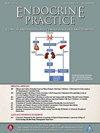Nondiagnostic Fine Needle Aspiration of Thyroid Nodules: Review of Predisposing Factors
IF 3.7
3区 医学
Q2 ENDOCRINOLOGY & METABOLISM
引用次数: 0
Abstract
Objective
Fine needle aspiration (FNA) of thyroid nodules is the gold standard screening test for thyroid malignancy. Unfortunately, FNA may produce insufficient material for diagnosis. If nodules requiring FNA with a higher risk for nondiagnostic (ND) cytology could be identified pre-procedure, this might allow better patient guidance and potentially facilitate an altered approach to FNA.
Methods
The literature investigating risk factors for ND cytology was reviewed, including studies of patient factors, sonographic or nodule factors, and procedural factors. Twenty-five studies that included assessment of at least two potential factors in ND outcomes for initial FNA were identified. Individual factors were evaluated in terms of the general consensus of studies reporting either a positive significant association with ND cytology or no association.
Results
Most patient and nodule factors lack consensus as far as their association with ND cytology across these studies. Factors where there are some consensuses include practitioner experience, depth of nodule, and cystic content; however, hypervascularity of the nodule does not appear to have a consensus.
Conclusion
A number of study design improvements suggested by this review could realistically be incorporated into higher powered future studies. Novel factors such as tissue composition anterior to the nodule or the age of the patient could also be investigated in future work. Operator experience is the most convincing procedural factor, and approaches to future studies of the FNA technique itself are proposed. That said, the factors with consensus among studies can be seen leading candidates for this future research, and the published studies illuminate a number of as yet unexplored factors that could in many cases be studied retrospectively.
甲状腺结节的非诊断性细针抽吸术:回顾诱发因素
背景:甲状腺结节的细针穿刺术(FNA)是筛查甲状腺恶性肿瘤的金标准。遗憾的是,FNA 可能无法获得足够的诊断材料。摘要:我们回顾了有关ND细胞学风险因素的文献,包括有关患者因素、声像图或结节因素以及手术因素的研究。确定了 25 项研究,其中包括对初次 FNA 的 ND 结果中至少两个潜在因素的评估。根据报告与 ND 细胞学有显著正相关性或无相关性的研究的普遍共识,对各个因素进行了评估:结论:大多数患者和结节因素与 ND 细胞学的关系在这些研究中缺乏共识。不过,本综述提出的一些研究设计改进建议可切实纳入未来的高能研究中。结节前组织成分或患者年龄等新因素也可在今后的工作中加以研究。操作者的经验是最有说服力的程序因素,我们也提出了未来研究 FNA 技术本身的方法。尽管如此,各项研究中达成共识的因素仍是未来研究的主要候选因素,已发表的研究阐明了许多尚未探索的因素,这些因素在许多情况下可以进行回顾性研究。
本文章由计算机程序翻译,如有差异,请以英文原文为准。
求助全文
约1分钟内获得全文
求助全文
来源期刊

Endocrine Practice
ENDOCRINOLOGY & METABOLISM-
CiteScore
7.60
自引率
2.40%
发文量
546
审稿时长
41 days
期刊介绍:
Endocrine Practice (ISSN: 1530-891X), a peer-reviewed journal published twelve times a year, is the official journal of the American Association of Clinical Endocrinologists (AACE). The primary mission of Endocrine Practice is to enhance the health care of patients with endocrine diseases through continuing education of practicing endocrinologists.
 求助内容:
求助内容: 应助结果提醒方式:
应助结果提醒方式:


